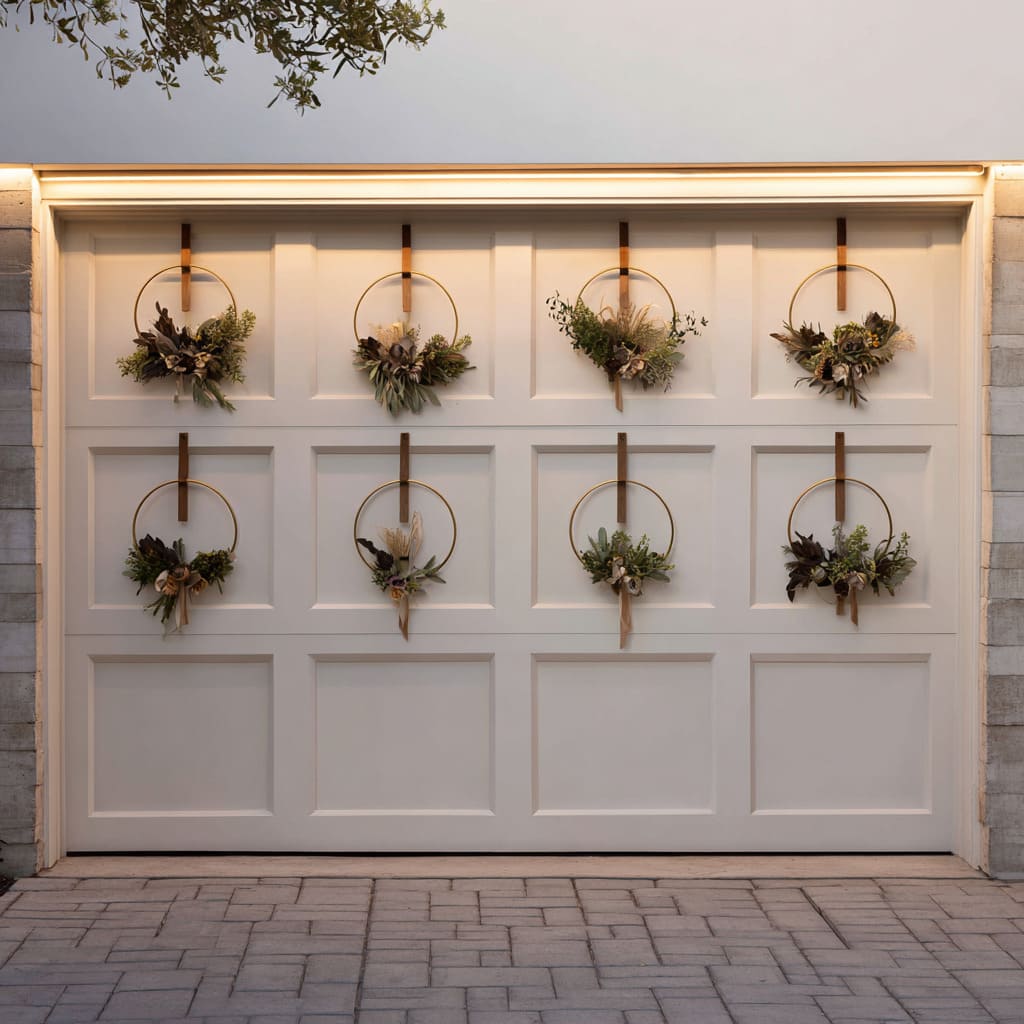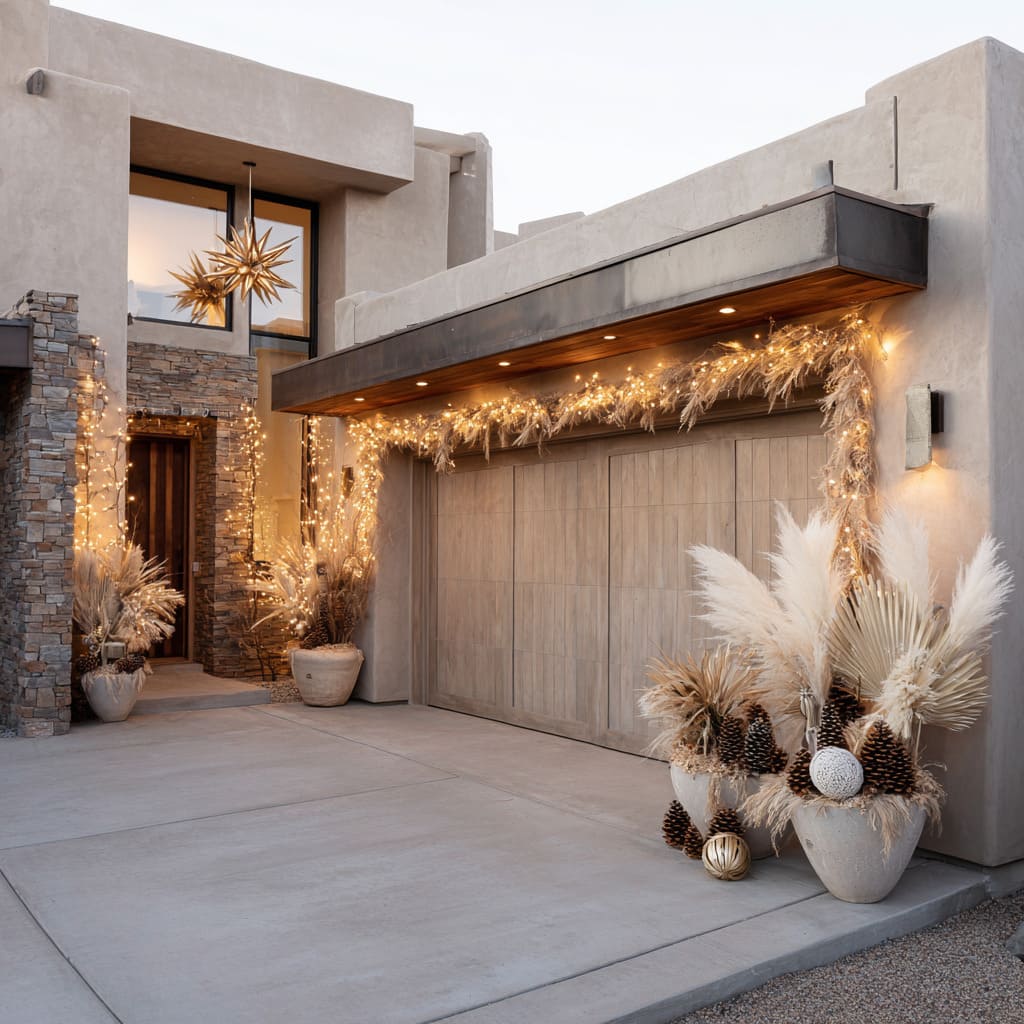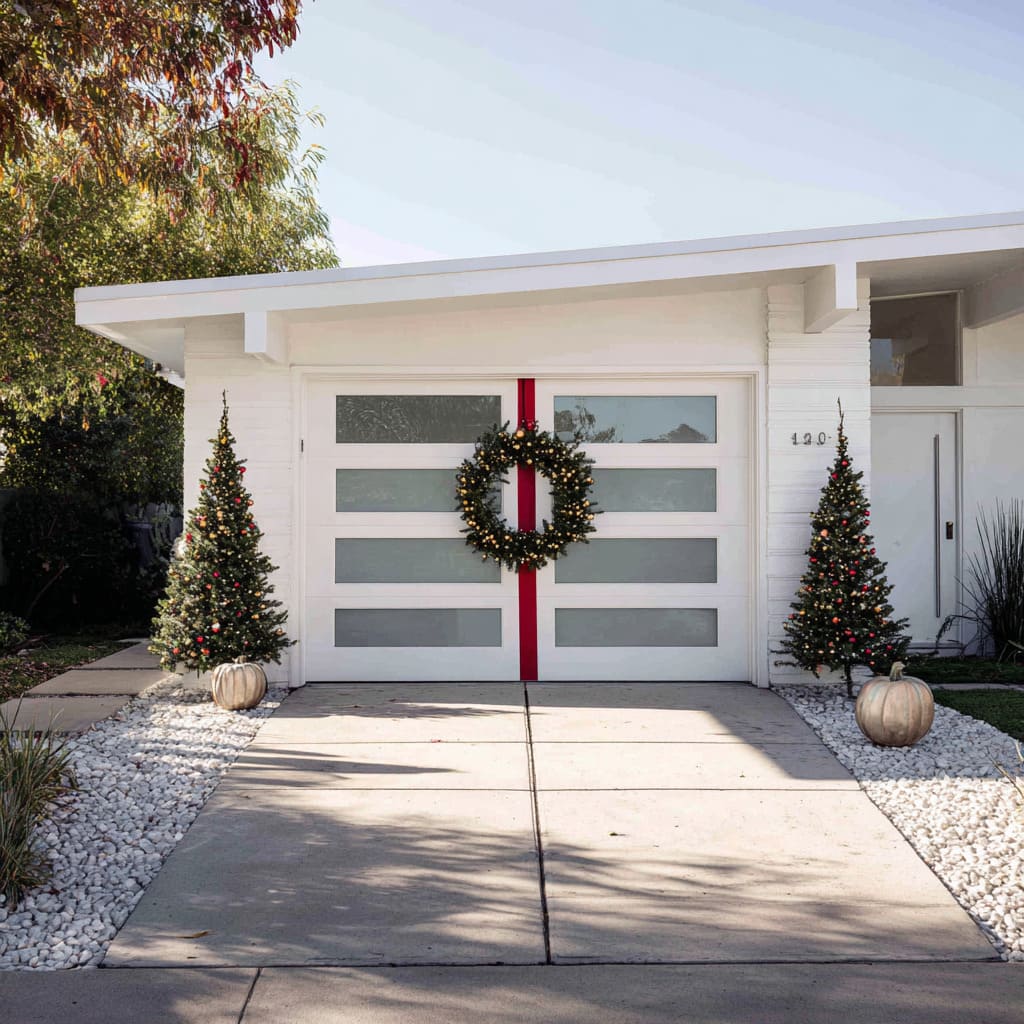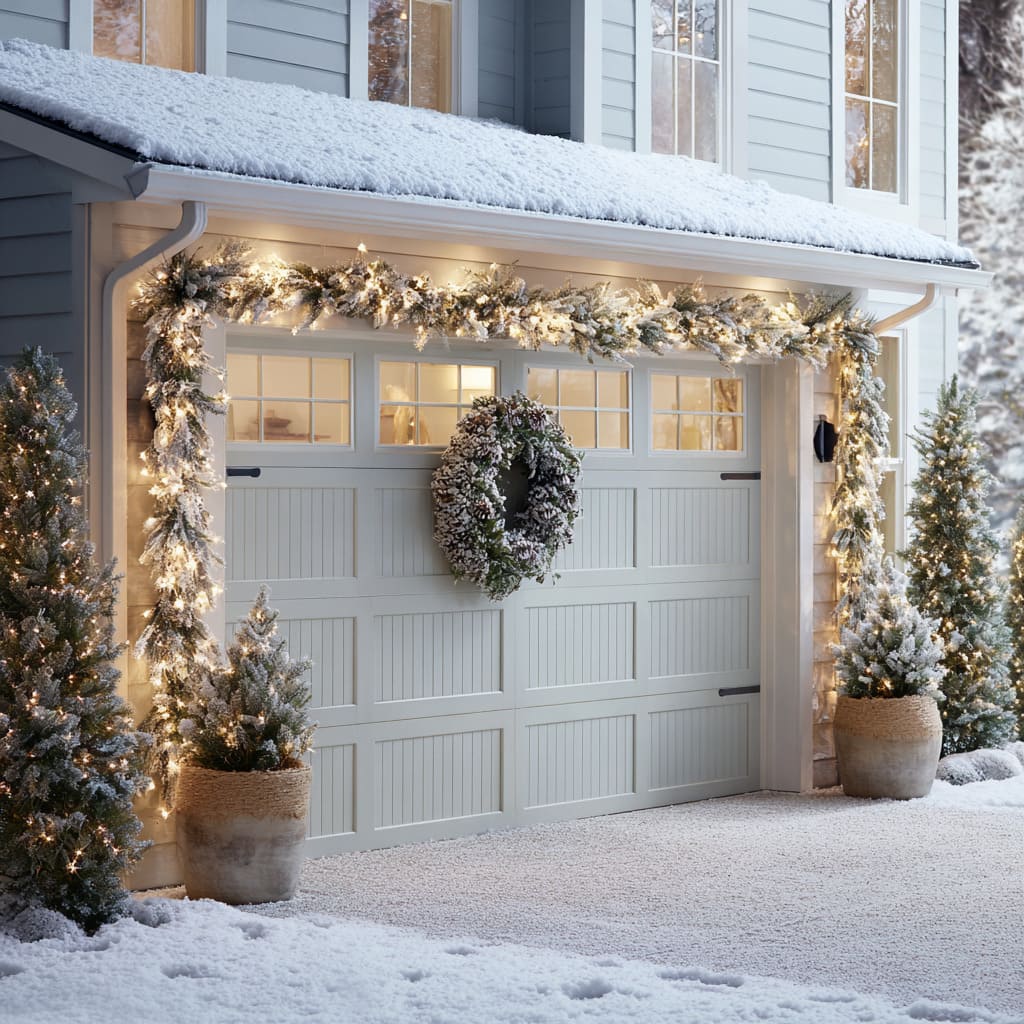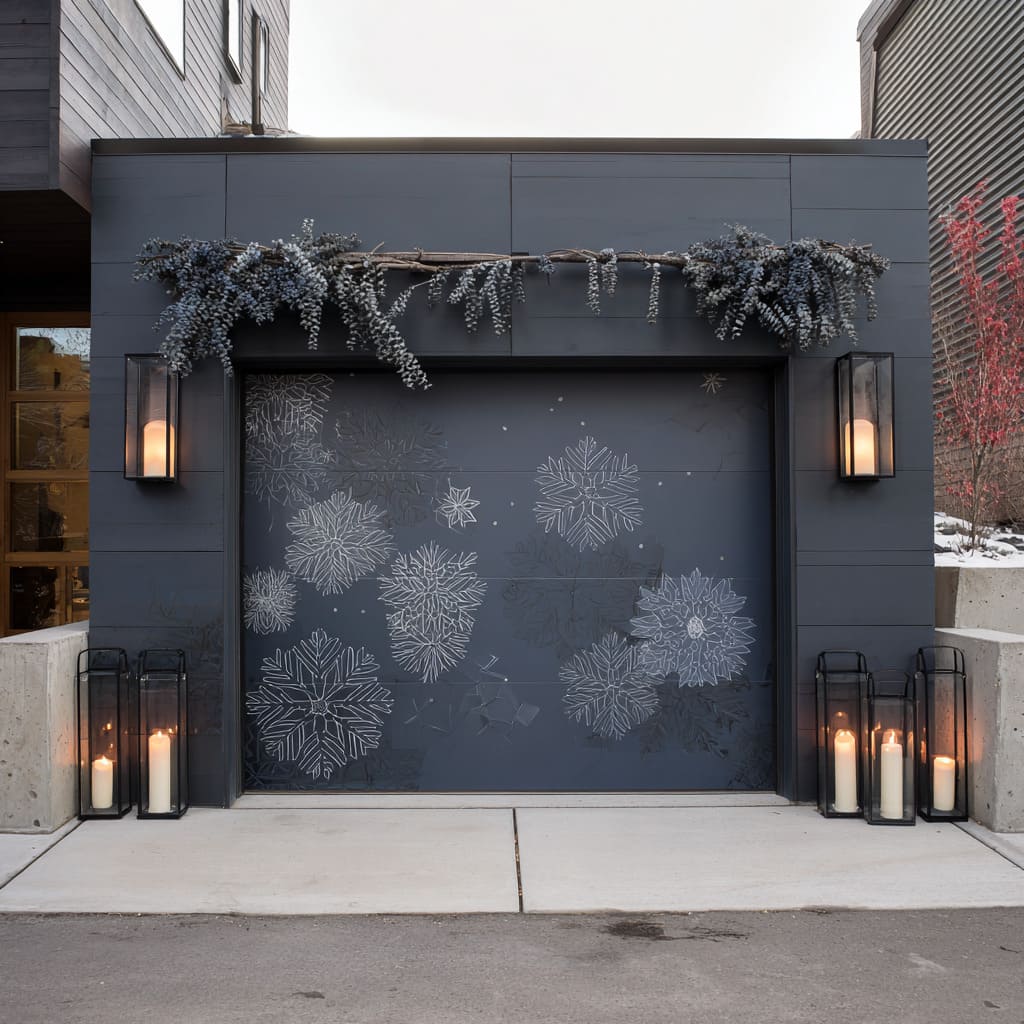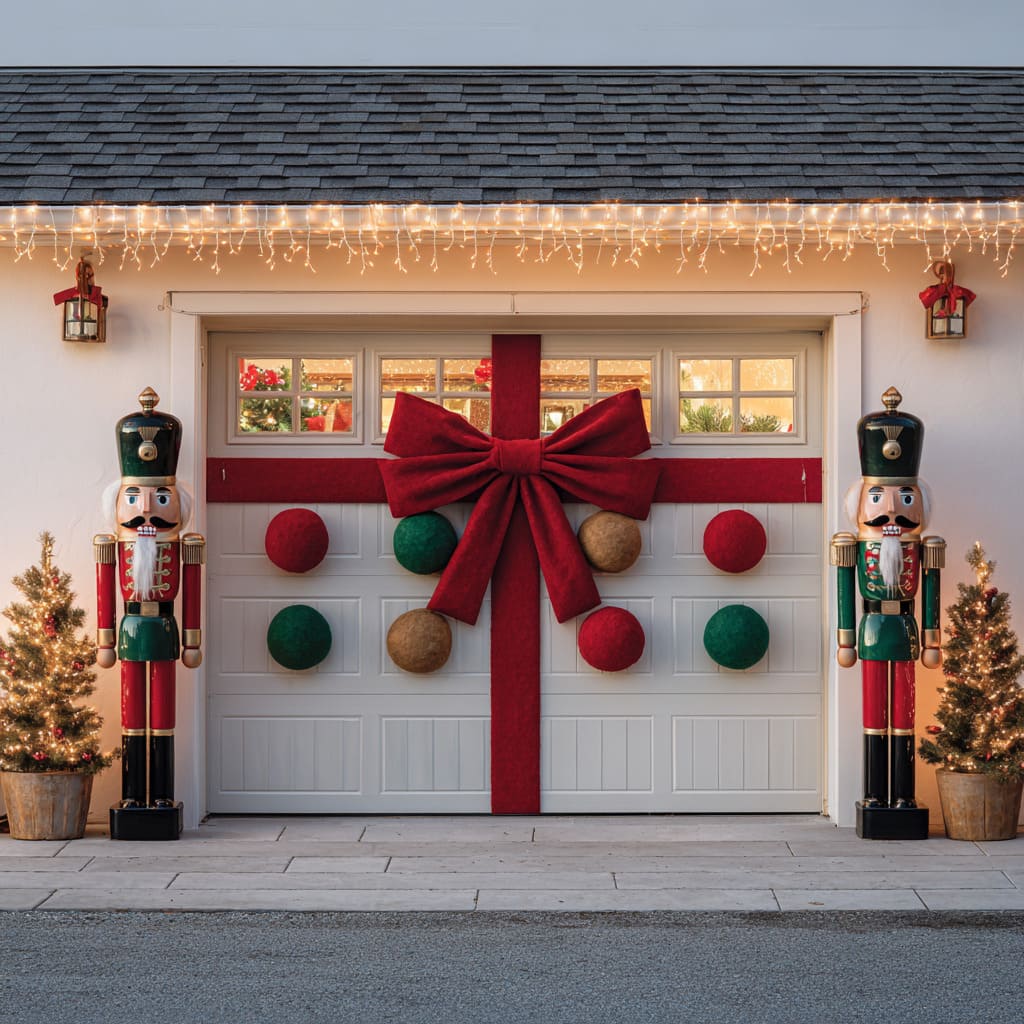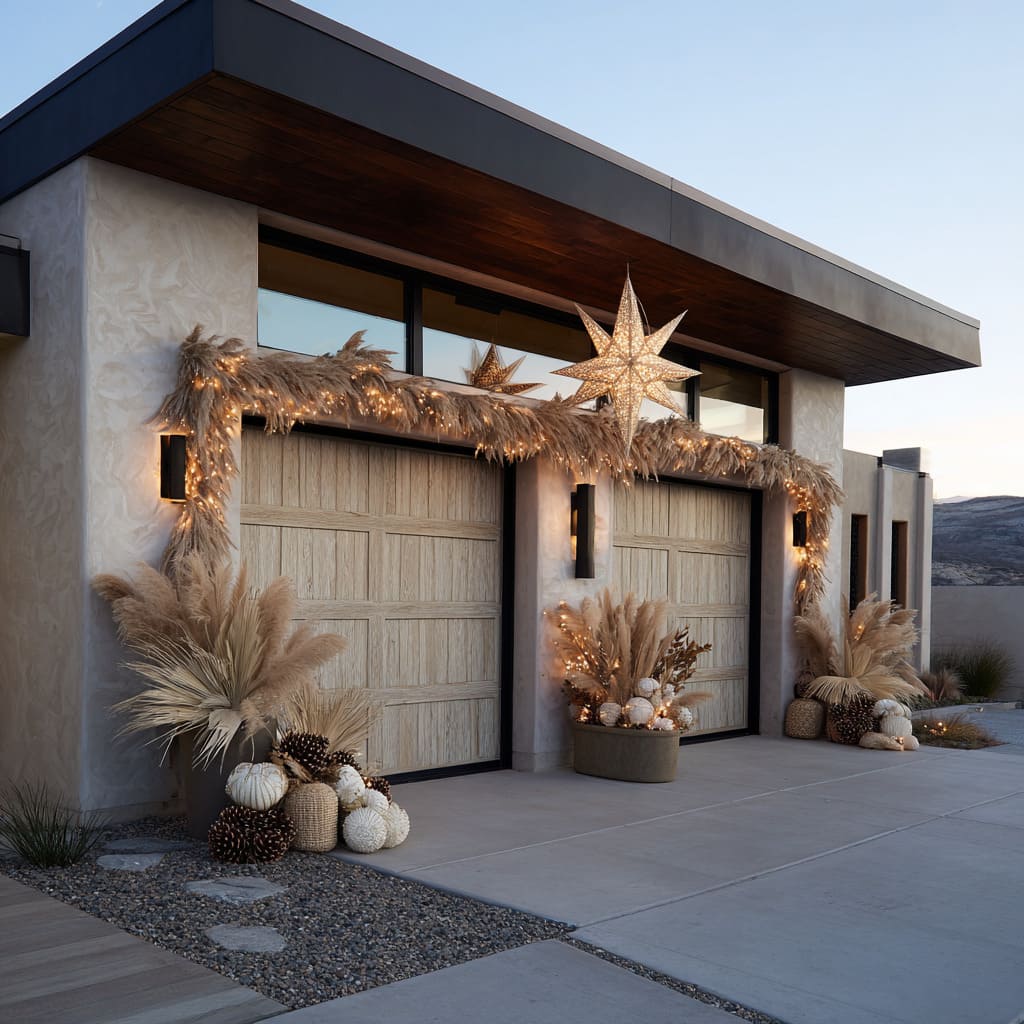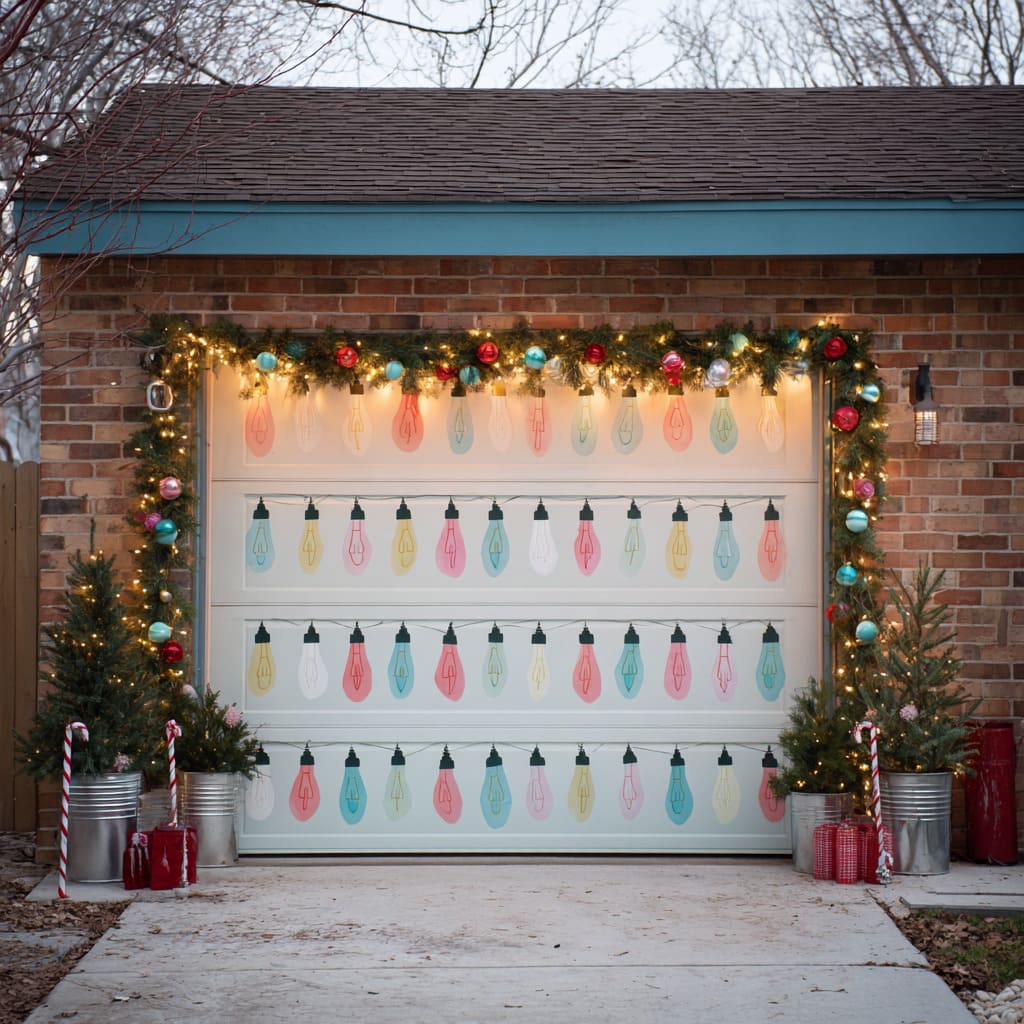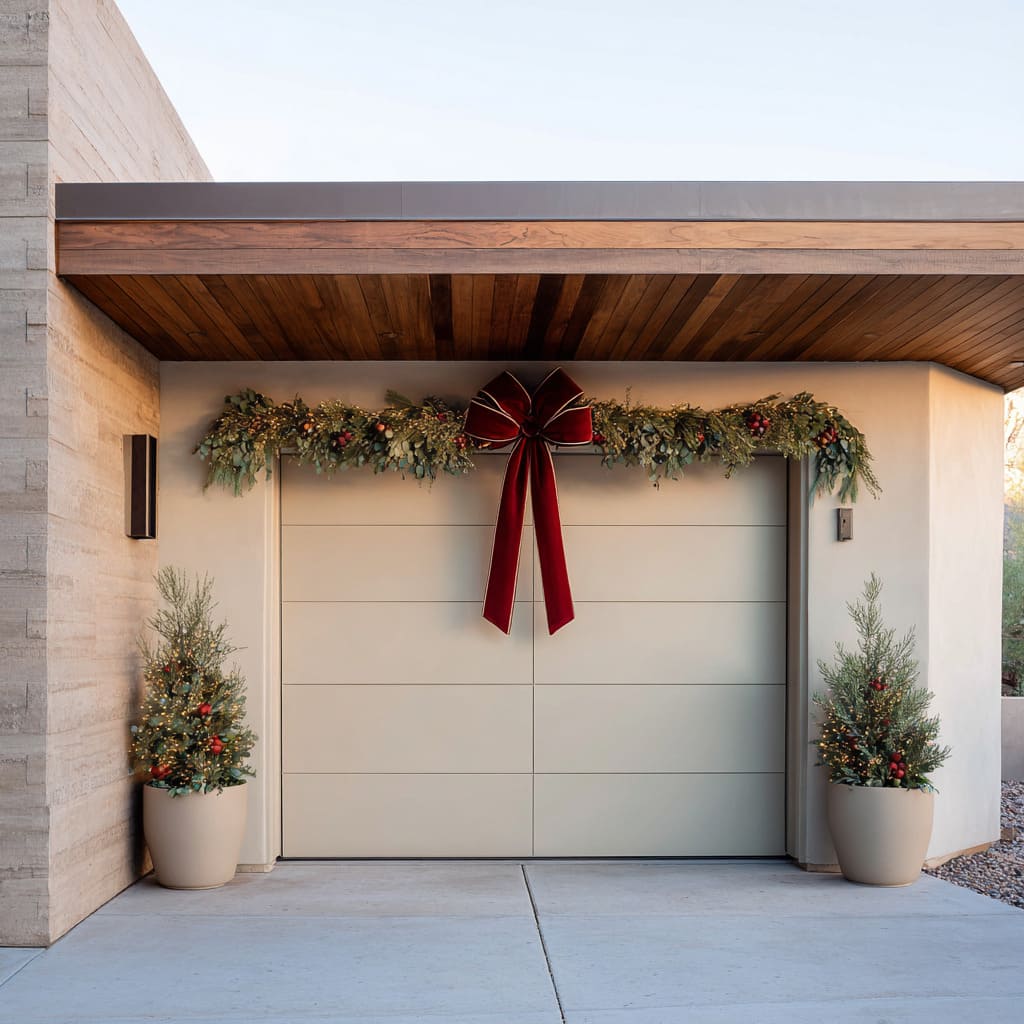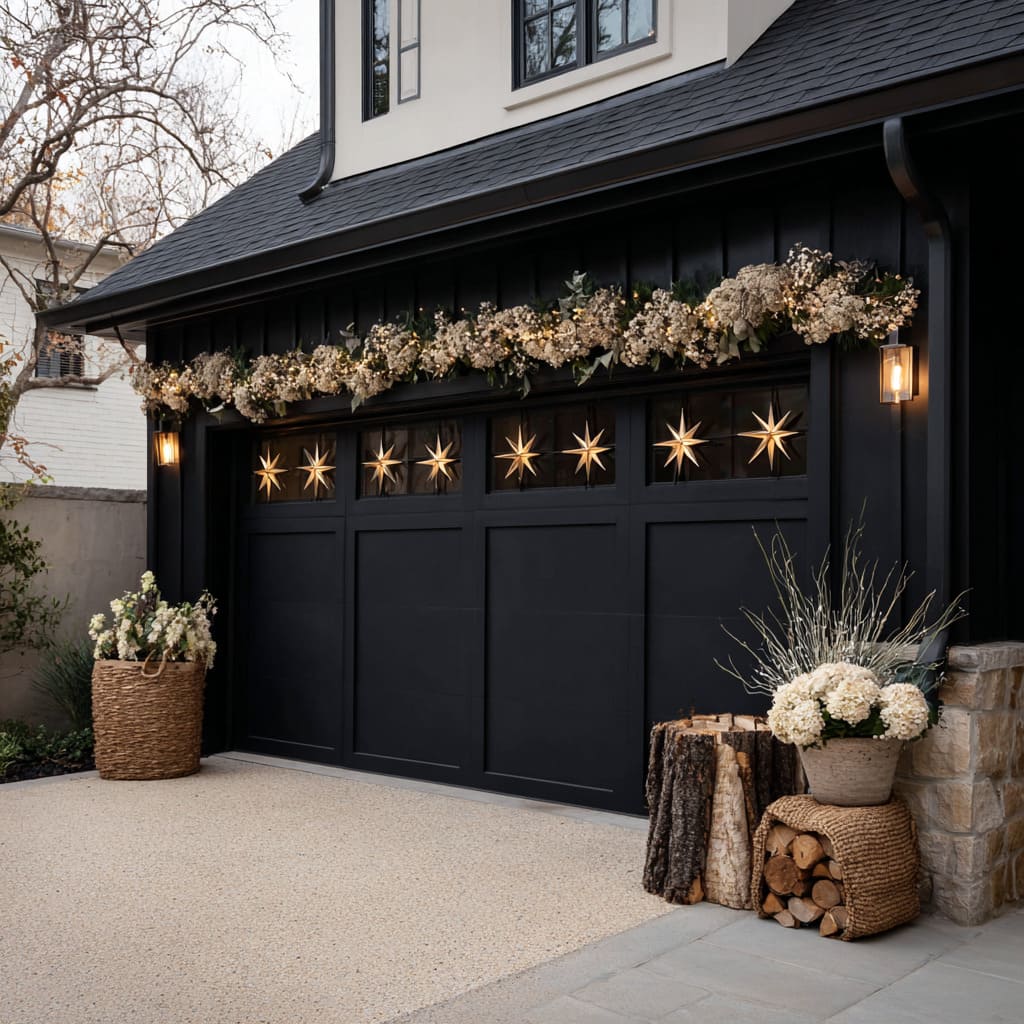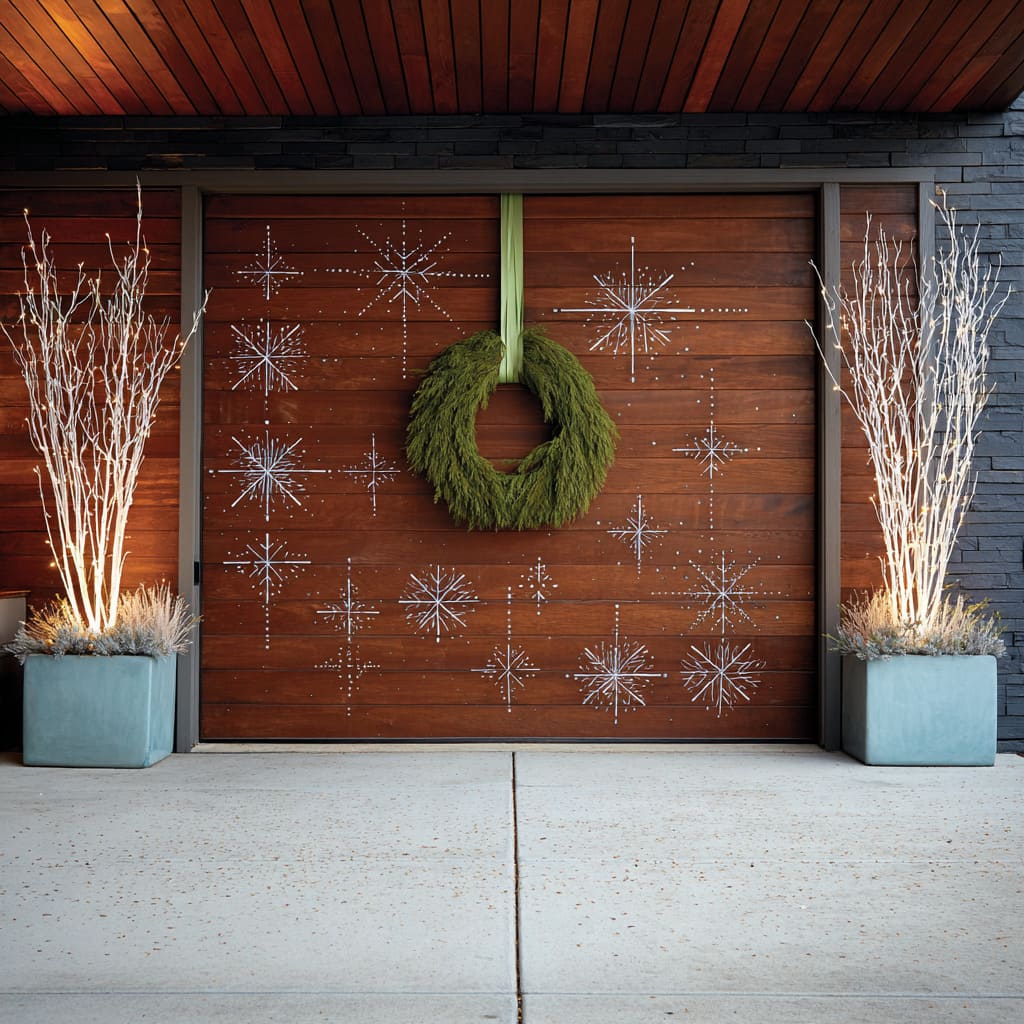Seasonal decorating has taken a quieter turn, especially in how garage doors are approached during the holidays. Instead of leaning on the usual overload of wreaths, lights, and bright red-green contrasts, recent Christmas garage door ideas focus on structure, alignment, and material language.
The surface of the garage is no longer treated as background—it acts as a canvas, an anchor, or even part of the display’s rhythm. This newer approach works through restraint, texture, and proportion, using design cues that echo the home’s geometry or bring attention to negative space.
Common holiday icons are often reinterpreted: a bow may shift in color or material, a tree might be reduced to its silhouette, or a wreath might float alone with nothing but light or shadow around it.
Color is used more thoughtfully—tones are muted, weathered, or regionally adapted—and materials play against each other in layers: soft grasses next to cold stone, matte greenery beside metallic ornaments, or faded wood framing abstract shapes. What emerges from this direction is a visual language built from contrast, silence, and rhythm, where every part of the composition is connected to its surroundings.
Holiday garage décor has moved far beyond statement pieces. It’s now about creating a visual atmosphere, one that speaks with intention—through light, shape, and texture rather than through volume.
Surface as Canvas: Architecture Becomes Message
What sets apart many modern Christmas garage door decorating ideas is how they allow the structure itself to speak. Instead of covering the door with ornaments or draping it as an afterthought, the surface becomes the lead visual layer—a functional wall turned into a seasonal display plane.
In some of the most visually powerful ideas, a stark mountain silhouette spreads across both the garage door and its overhang, forming a striking graphic landscape. The mural doesn’t recede behind the décor—it drives the entire visual logic.
The garland isn’t floating above for flair—it wraps the mural like a proscenium arch, adding weight and rhythm to the composition. The whole door behaves less like an entry point and more like a deliberate backdrop for an installation.
In another quiet, restrained idea, a matte grey garage surface turns into a drawing pad, softly marked with etched snowflakes that appear and disappear depending on the light. Some flakes are sharply visible; others dissolve into the shadows, creating motion without movement.
This subtle layering allows the garage to act like a fogged window rather than a billboard. Elsewhere, geometric decals—clean white starbursts placed in perfect grid—transform the door into a starlit map, hinting at winter constellations without ever stating them.
The shine isn’t for sparkle—it’s for structure, creating clarity and balance in the layout. These kinds of holiday garage door decorations don’t treat the surface as something to be hidden or ignored.
The garage door becomes part of the language of the design, building a rhythm between decoration and architecture. Visual weight and spacing echo the home’s structure, so every line feels like it belongs.
Ornament as Sculpture: Material Stiffness Matters
One quiet detail that sets such designs apart from generic outdoor holiday scenes is how ornaments and ribbons are treated not as accessories but as sculptural forms—defined by material stiffness, weight, and shape retention. In one striking example, a massive red ribbon wraps across a black garage door like a belt, but it doesn’t drape.
It holds its shape with precision—sharp curves, crisp shadows, and a three-dimensional lift that makes the bow feel carved, not tied. It’s this physical tension that makes the visual feel intentional and anchored.
Some designs use plush ribbon that adds visual softness without collapsing under its own weight. A thick, velvety bow, centered over a door wrapped like a present, brings in just enough volume to contrast the verticality of two nutcracker guards.
The ribbon’s soft bulges and seams catch the light like a fabric sculpture—breaking the hardness of surrounding lines without becoming overly sweet. Another standout feature involves a vertical ribbon drop ending in a stack of golden sleigh bells, suspended in perfect alignment.
These aren’t thin craft store bells—they’re heavy, metallic, and clearly weighted, giving the composition a center of gravity. The vertical line becomes a tension cable holding the foliage together.
These sculptural touches are about presence, not prettiness. Garland isn’t limp or stuffed—it’s formed with direction.
Ornaments don’t clutter—they punctuate. Bows aren’t decorative—they carry form, weight, and light.
This approach turns holiday garage door decorations into something more sculpted, more structured—objects that hold their own against the architecture rather than decorating around it.
Rejection of Red-Green as a Default
Across many of the most visually refined Christmas garage decorating ideas, the expected color palette of bright red and evergreen has been reconsidered—or stripped back altogether. What emerges instead is a more atmospheric use of color, built from restraint, association, and tone memory rather than tradition.
A garage framed with classic greenery might still feature a red bow—but only one—and even that red is deepened, matte, or velvet, making it read more like a sculptural note than a symbol. The green garland may be softened with brushed gold or dusty copper tones, quieting its presence rather than amplifying it.
The whole setup draws attention to the absence of repetition, giving the red bow a deliberate weight.
Other compositions go further: muted mid-century tones—butter yellow, faded turquoise, powder pink—hint at vintage ornaments without repeating their literal form. These colors don’t announce festivity; they suggest it through memory, like a holiday palette seen through soft glass.
And then there are designs built almost entirely on faded winter hues—pale grey, cream, bleached fir, soft bronze. Here, color is atmosphere, not punctuation.
The garage becomes a winter field or a dusty snowbank, more about season than spectacle. What these Christmas garage door decoration ideas have in common is emotional tone over visual volume.
They leave space for interpretation. Instead of grabbing attention, they invite a slower gaze—not by turning away from color, but by using it with purpose and quiet tension.
Tension Between Control and Casual
One of the most subtly powerful tools used in such garage displays is the play between structure and softness—between deliberate form and something slightly unruly. This visual push-pull creates a feeling that is styled, but not sterile.
Take a scene where the doors are symmetrically aligned, the planters centered, and the garland tight—and yet, the raffia bows at the center of each wreath trail in uneven, frayed strands. That rough texture interrupts the order.
It makes the moment feel alive, like something real rather than arranged.
In another, a strict grid of botanical hoops is hung with absolute regularity across the garage surface—each hoop the same size, spaced evenly. But inside those hoops, the arrangements break rank: grass blades curl in opposite directions, eucalyptus sprigs arc unevenly, and dried pods rest off-center.
The eye reads the control first, then registers the break, creating a tension that’s engaging but not loud. Sometimes the casual note comes from movement.
A thick garland might be swept across the frame in arcs, creating wide flowing curves that resist the straight lines of the garage panels. That shape might not match the rest of the house’s symmetry—but it breaks the repetition in a way that adds energy without noise.
These decisions are subtle, but they’re crucial. They prevent the scene from feeling overly fixed.
By letting one element misbehave within a structured setup, the design stays visually human—polished, but not staged. And that’s part of what makes the best Christmas garage decorating ideas feel current: not through perfection, but through controlled contrast.
Use of Negative Space as Visual Anchor
In many of the most visually refined garage door Christmas ideas, what’s left untouched becomes as powerful as the elements that are added. Negative space doesn’t fade into the background—it shapes the atmosphere, framing focal points and giving them the quiet strength of isolation.
Consider a single wreath, placed directly at the center of a wide, matte black door. The absence of other elements turns that wreath into a visual anchor, pulling focus by floating alone in the middle of an open field.
The surrounding blackness adds scale, clarity, and weight. What could have been ordinary becomes monumental by what isn’t around it.
In another case, a red ribbon sliced slightly off-center across a white door changes the mood entirely. The asymmetry doesn’t feel accidental—it emphasizes direction.
It allows the door’s surface to breathe, and the restraint gives the ribbon visual sharpness, without making the display feel sparse. Some ideas resist the urge to outline or cover.
Instead of tracing the edge of the garage with greenery, the garland may be placed above the frame, hovering like a line of punctuation, while the rest of the structure remains untouched. This space below reads as intentional air—not emptiness but volume.
It allows the eye to rest and gives the decor overhead more impact. Such designs work with space, not against it.
The blank surfaces aren’t waiting to be filled. They’re part of the composition.
In this way, garage door Christmas ideas often rely as much on silence as on statement.
Interplay Between Light and Surface Texture
Across the best modern setups, light is handled as material—not just as brightness, but as a way to activate surface texture and control rhythm. Whether it’s reflected, projected, or embedded, light shapes how each element feels, not just how it looks.
Take a black door trimmed with glowing snowflake tubes. These aren’t standard string lights—they’re structured forms, and the light seems to sit inside the darkness, like glowing outlines on a velvet field.
The matte surface amplifies their shape by muting glare, letting form lead instead of brightness.
Other garage door Christmas light ideas use fairy lights sparingly—but with a clear plan. A sweep of pampas garland along a low awning glows with soft internal lighting, casting a golden haze that gives dimension without crowding the scene.
The light climbs upward and spills gently through textured grasses, making the whole frame feel layered from the base to the top. And then there are setups that make use of projected light—snowflake patterns dancing slowly across the door and façade.
These aren’t static decorations; they move subtly, turning the structure into a quiet canvas of motion. The architecture doesn’t disappear—it becomes part of the visual rhythm.
Here, light is not about sparkle. It’s about touch.
It enhances the texture of wood grain, amplifies matte finishes, and animates stillness with rhythm. These examples don’t rely on brightness—they use light the way a sculptor might use shadow: to shape the form and define the mood.
Symbolic Substitution and Quiet Allusion
One of the most refined shifts in current christmas garage ideas is how visual language moves away from direct symbols—like Santa figures, candy canes, or sleighs—and leans into interpretive shapes and textures that carry meaning without spelling it out. Instead of bright red bows, some scenes feature linen-textured bows in washed cream, paired with soft olive-toned wreaths.
These changes aren’t random—they carry the same seasonal cues, but through textile reference and tone rather than high-contrast symbols. The look hints at warmth and tradition but through materials that speak quietly.
Elsewhere, traditional evergreen garlands are replaced with flows of golden pampas, bleached straw, or curled dried leaves. These aren’t garlands in the pine-and-baubles sense.
They’re regional flora arranged in sweeping shapes, mimicking the silhouette of holiday greenery without using it. The substitution isn’t a compromise—it’s an intentional nod to climate, culture, and place.
In some rare but striking designs, Santa himself is reduced to shape and color—a pale blue faux-wood door with a large red curve, a block of beige, and a wave of white for the beard. There are no facial details, no belt buckles—just geometry and recognition through memory.
It reads as a sign, not a character, blending humor and restraint without cartooning the space. The power here comes from suggestion.
These decorations don’t tell stories—they suggest impressions. Meaning is conveyed through texture, silhouette, material substitution, and association.
It’s a kind of visual shorthand that lets the garage front speak in a quieter, more contemporary accent.
Compositional Flow: Horizontal vs. Vertical Logic
Many standout ideas build their entire visual strength around how the composition relates to the home’s structure. The direction of elements—whether pushing outward across or drawing upward vertically—is rarely accidental.
These layouts understand the garage front as both a visual plane and a three-dimensional volume. In homes with long horizontal proportions, every choice supports that span: garlands stretch like ledges, oversized wreaths float low and wide, and planters sit close to the ground in rows.
The entire layout runs parallel to the roofline, reinforcing the home’s shape instead of cutting across it.
In contrast, other ideas lean into strong vertical rhythm. Tall nutcrackers at either side of the door, stacked ornaments forming a spine, or topiary trees trimmed in vertical spirals—these vertical anchors create lift, even when the architecture itself is horizontal.
Some doors are wrapped with a ribbon running straight down, drawing the gaze from light fixtures above to lanterns below. There are also compositions that avoid either extreme.
One clever example builds a diagonal flow—zigzagging across the garage front with sharp mountain mural peaks, echoed by garland sweeps and angled tree branches. This layout builds visual tension and movement, making the viewer’s eye travel deliberately across, up, and back down without resting too soon.
Compositional direction gives structure to everything else. Whether working with symmetry or slicing across it, these setups define how the space feels.
They decide whether the garage behaves like a backdrop, a screen, a framed surface, or a sculptural form. And that control of flow is what separates forgettable decor from visual architecture with rhythm.
Material Juxtaposition as Styling Philosophy
One of the most refined visual techniques used in today’s garage displays is the play between opposite surface qualities. These aren’t random material mixes—they’re chosen with a clear sense of contrast: hard against soft, polished beside rough, reflective near muted.
It’s this friction that gives the scenes depth. In some cases, a high-shine garland packed with glossy red and silver ornaments is paired with bare, jagged red branches jutting out from planters.
The result is tactile tension—a theatrical finish layered over a sharp, natural silhouette. It’s not about balance, but about contrast that holds the viewer’s eye.
Other displays lean into rustic detail. A clean white lap-siding façade might sit directly behind a pile of uneven firewood in open crates, alongside hand-cut raffia bows and exposed root bundles.
Nothing is smoothed or softened. The textures are left coarse, sometimes even messy—but always deliberately out of sync with the clean backdrop.
This pushes the eye to travel back and forth between raw and refined. Even subtle contrasts can shift the tone.
In some setups, muted dried florals are layered against deep matte black surfaces. Instead of brightness, they absorb light, giving the scene a faded winter garden feel.
The usual sparkle of holiday decor is replaced with a more dreamlike haze, where reflection is minimized and texture takes over. These are not decorations thrown together—they’re material conversations.
Each object earns its place through how it behaves next to its neighbor. It’s this type of curation that gives garage styling more than visual structure—it gives it tension, rhythm, and visual sharpness without being loud.
Quiet Modernism with Emotional Depth
In contrast to flashy displays that aim to impress through size or shine, there’s a growing group of garage designs that create impact through stillness, softness, and emotional temperature. These aren’t theatrical scenes—they are quiet visual climates.
Some of the most striking examples use very little decoration at all. A surface might hold nothing more than a handful of faint snowflake outlines, their shapes barely visible against soft grey siding.
Add a low amber glow from nearby sconces, and the garage doesn’t become a billboard—it becomes a suggestion of winter, like breath on cold glass.
Other ideas lean on subtle repetition. Wreaths frosted with uneven snow, hung alone on a pale blue background, barely catch the light.
Their icy tone is mirrored by garlands and trees nearby, but always in the same faded register. There’s no bold color, no oversized symbols—just a sense of being in season without performing it.
And then there are designs that align perfectly with the home’s structure, letting the house guide the decor rather than covering it. Garlands trace the lines of eaves; wreaths hang in the center of clean white panels; nothing spills, sags, or shouts.
Everything feels quiet, but complete. Such designs work not by adding noise, but by removing it.
They use space, tone, and control to create an atmosphere—one that feels colder, slower, softer. It’s a visual silence that stays with the viewer, even after the lights are off.
Conclusion: Composed Expression Over Holiday Excess
What stands out in modern Christmas garage door displays is their ability to shape mood without relying on overstatement. These ideas move far beyond decoration—they’re structured responses to light, proportion, material, and memory.
Each one acts as a quiet composition, responding not only to the season but to the structure it’s part of. Rather than covering the garage, these ideas work with it—treating the surface as a frame, a skin, or a visual anchor.
Decoration is placed with awareness, not scattered. The result is styling that feels complete through restraint, not volume.
Here are the key moves that define this visual approach:
- Alignment with architectural lines, allowing decor to follow, trace, or echo the shape and rhythm of the home
- Controlled asymmetry and planned irregularity, giving balance a more human and tactile quality
- Minimalist tension between materials, where contrast—soft vs. sharp, matte vs. shine—builds depth
- Light and shadow as emotional triggers, using glow, projection, or dimming to change how texture behaves
- Seasonal motifs reinterpreted through shape, memory, and surface, rather than repeated symbols
Each concept avoids formula. Nothing leans on excess.
These are compositions built on texture, silence, tone, and structure—a visual language that doesn’t ask to be loud to feel complete. In this way, the garage becomes something more—it becomes a part of the seasonal expression itself, responding to region, climate, and style without relying on cliché.
The most refined Christmas garage door ideas work because they feel rooted—not in trend, but in place, proportion, and presence.


